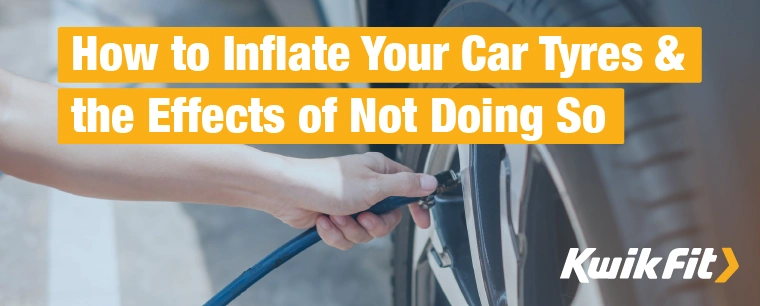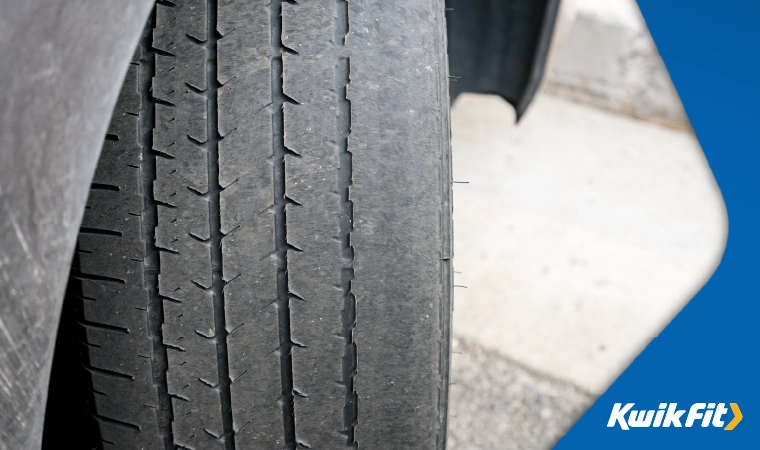How to Inflate Your Car Tyres & the Effects of Not Doing So
Jack Dreyer | Wednesday 10th January 2024 10:00am

Tyres are the most abused components of cars – yet, alongside your brakes, tyres are by far the most important components. But in order to keep them safe and to keep them working efficiently, your tyres need to be inflated properly. Tyre pressure can affect many aspects of your vehicle’s performance, such as braking distance, tyre lifespan, steering accuracy, and fuel economy.
We’ll get on this in more detail later but, in short, underinflated tyres sag onto the road surface and wear faster, while overinflated tyres tend to have less contact with the road and therefore have weak grip. This, clearly, increases the risk of accidents - because it increases the risk of your car skidding.
But neglecting your tyres could land you in legal trouble too. Driving with tyres below the legal minimum tread depth (1.6mm) can land you with a £2,500 fine and 3 penalty points against your licence. So ensuring you have a sound understanding of how to correctly inflate your tyres is fundamental to your driving experience - and safety.
Here’s how to check your tyre pressure, how to inflate your tyres properly, and the problems that occur when they’re not at the right pressure.
Checking your tyres
Before you begin inflating your tyres, you need to check their current air pressure. In order to do so, you will need a pressure gauge that uses the same unit of measurement as the pressure guidelines provided for your car. If you don’t have one, almost all petrol stations will include one in their self-service air pressure pumps on the forecourt.
The optimal tyre pressure for your vehicle can be found using our Tyre Pressure Search tool. Alternatively, it’ll be in your owner’s manual, or, if you don’t have access to the manual, you can find the value inside the fuel cap or on a manufacturer’s sticker inside your car. Tyre air pressure is measured in PSI (Pound per Square Inch) and is usually the same for all four tyres.
It is important to remember, however, that air pressure will need to be increased in all four tyres if you are towing or carrying a heavy load.
Once you know the recommended tyre pressure, you’ll need to check all four tyres against it (the recommended pressure is usually different for the front and rear tyres). On each tyre, remove the valve caps and keep them somewhere safe. Then, insert the gauge into the tyre valve. In most petrol stations, the air pump itself will come equipped with a gauge metre on it. Take the reading from the metre.
If the tyre pressure is lower than the PSI for your vehicle, you’ll need to add air. Conversely, if the pressure gauge reads higher than the recommended PSI, air will need to be removed.

How to inflate your tyres
The fundamental process of inflating your tyres stays the same regardless of how you do it, but there are slightly different procedures based on what equipment you’re using and where you’re using it.
Inflating your tyres at a garage
To add air to your tyres, simply insert the air pump into the tyre valve and squeeze the trigger. This should be done in short bursts for accuracy and so as not to over-inflate the tyre. Keep squeezing the air pump trigger in short spurts until the PSI reading on the gauge matches the optimum value for your car.
Alternatively, if air needs to be removed and pressure lowered, pull the nozzle of the air pump slowly out of the tyre valve to release the air. You will hear a sharp hissing noise as the air escapes — this is normal.
Again, this process should be done in little bursts to prevent all of the air from escaping the tyre. Keep gently moving the nozzle in and out of the valve until the PSI reading lowers to meet the recommended value found in your owner’s manual.
Once the tyre is as close to the optimal tyre PSI as you can get it, quickly replace the valve caps and move on to the next tyre. If you have the time, remember to inflate or deflate your spare tyre too — this may save you some trouble if you break down.
Inflating your tyres at home
Many people opt for a portable air pump that they can use at home instead of driving to the petrol station. You should fundamentally follow the steps above as if you were operating a usual air pump system, but here are some additional pointers.
Portable pumps either come as electrically-powered or manual options. With electric pumps, you usually have to plug them into the car’s cigarette lighter port, turn them on, and select a target pressure. Turn them off again before attaching them to the tyre valve stem (so the motor doesn’t keep running) and switch them back on when the valve is connected properly.
They should pump until the desired pressure is reached and then turn off. But be sure to watch in case your pump doesn’t have an automatic cutoff function!
Manual pumps are a bit more work but work in the same way – the only real difference being that you have to keep an eye on the pressure gauge to know when to stop.
Tyre inflating tip:
Wherever you check your tyre pressures, make sure to do so when they are cold to avoid inaccuracies. Since air expands when it is warm, the pressure of your tyres will be much higher if you take a reading as soon as you’ve finished driving, compared to after a few minutes of being parked.
Tyres not holding air?
If your tyres aren’t holding air, you may have a slow puncture. Book your car in for a free tyre inspection at your local Kwik Fit to be safe!
The effects of underinflated tyres on your vehicle
So now that you know how to inflate your tyres whenever and wherever you need to, it’s also important to understand the effects of improper tyre pressure on your car - as well as on the tyres themselves.
Uneven tyre wear
When you drive with under-inflated tyres, the sidewalls of the tyre can become misshapen and bulge out, because there’s not enough internal air pressure to hold the correct tyre shape. As a result of the sidewalls bulging, the edges of the tyre tread get much more wear than usual, because they’re in contact with the ground more often.
This is actually a desirable thing in some rare cases (like with drag racers) because the slack tyres can grip the road enough to launch the car at the level of acceleration needed. But this is very precisely calculated for each race and, if you’re reading this, you’re unlikely to be driving a drag racer!
At best, this can cause premature tyre wear in normal cars – but if left for too long, excessive wear can lead to tyre bursts in areas where the rubber is too thin to hold the pressure.
If you see any particularly bulging parts of your tyre, you should be very careful of them when driving and get them replaced immediately.
Crucially, avoiding this excessive tyre wear makes it considerably cheaper for you – as you’re not having to replace your tyres prematurely.
Poor fuel economy
This is another by-product of the tyres making more contact with the road. Because there’s additional surface contact with the road, there’s more friction, which means that there’s more force holding your car in place – or, rather, there’s more friction slowing your car down.
This, in turn, means that your engine has to work harder to go at the same speed, so you end up using considerably more fuel than you should be.
Unresponsive steering
Because the tyre rubber has more slack in it when it’s in its unpressurised state (or at least its less-pressurised state), your steering will be more sluggish. That’s because it takes more of a side-to-side turn to actually turn the tyre itself.
Think about holding a strip of rubber, if you hold both ends tight and turn one end, it twists. There will always be a certain amount of twist in the rubber of your tyres, but tyres are developed to withstand a certain amount of necessary friction at the correct pressure.
So, not using the correct pressure here means that it becomes harder to control your car at speed – it’ll seem like it’s bouncing around bends rather than holding its grip on the road.
More than tyre pressure problems?
If you’re having problems with your tyres, steering, or anything else – don’t put off getting in touch with your local Kwik Fit centre. Our experts are always on hand to advise, service, and repair your car.
Any facts, figures and prices shown in our blog articles are correct at time of publication.
Featured Articles
Is it Illegal to Drive With One Headlight?
Saturday 19th July 2025
Wondering if it’s illegal to drive with one headlight? Learn about the safety risks and penalties of illegal blown bulbs and why you should fix them promptly.
Air Con in EVs & Hybrids: Experts Answer Your Questions
Monday 30th June 2025
Does air con drain EV batteries? Can you use the air con while charging an electric car? Find out the answers to these questions & more from Kwik Fit’s experts.
Why Is Your Car Making a Noise? Fixes & Tips
Friday 13th June 2025
When your car starts making unexpected noises, it can certainly be quite disconcerting; it may be nothing to worry about, but here’s what you need to know.









